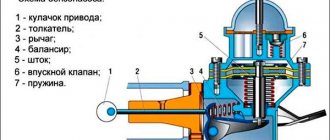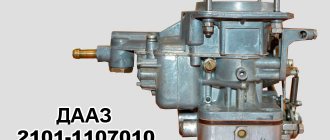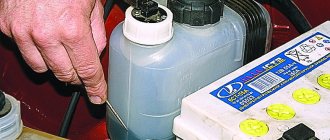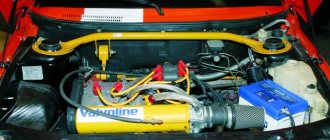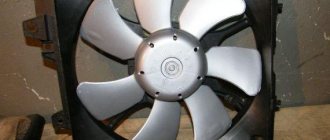There are practically no components and mechanisms left in the car that are not connected to an intelligent fault detection system. The exhaust system is also monitored in real time, so if its individual elements are unstable, a warning may appear on the dashboard, consisting of an alphanumeric code and a description of the problem in English. A catalyst malfunction by the monitoring system is determined by code p0420 and the message: Catalyst System Efficiency Below Threshold.
Symptoms of the error
In addition to the appearance of error p0420 on the digital display, a decrease in catalyst performance can be determined by the following signs:
- Increased fuel consumption.
- Reduced engine power.
- Difficulty starting the engine.
- Check Engine light is on.
- Floating idle speed.
If the problem in the operation of the catalyst is related to the physical destruction of the element, then rattling noises from under the bottom of the car are possible. If even one symptom is present against the background of the error p0420, it is possible to state with a high degree of confidence that the catalytic converter has failed.
Why does the catalyst clog?
The catalytic converter acts as a filter, and any filter element becomes unusable over time due to the accumulation of dirt. In the case of a catalyst, contamination can be accelerated by such malfunctions as:
- ingress of coolant or oil;
- low fuel quality;
- bad firmware of the control unit;
- gas equipment with an incorrectly configured control unit;
- mechanical damage;
All of the above reasons accelerate the clogging or melting of ceramic honeycombs.
Causes
Error p0420 can also appear for many reasons. The operating conditions that most negatively affect the performance of the catalyst are:
- Use of low-quality fuel.
- Mechanical damage.
- Operating a car with a faulty ignition system (primarily with constant misfire in the cylinders).
They have a negative impact on the condition of the catalyst and the malfunction of other parts and elements. For example, malfunctions in the operation of this part can be observed if the oxygen sensor, manifold, or muffler are damaged. Burnout of gaskets in the exhaust system also has a negative impact on the performance of the catalytic converter and lowers the response threshold of the sensor that displays error p0420.
Once the causes of catalyst failure have been correctly identified, you can begin to eliminate them.
Consequences of late diagnosis and repair
What could be the consequences of untimely elimination of the Check Engine? The list here can be quite long. Let us describe the main reasons and problems:
- The failure of one element can lead to a chain reaction that will lead to more complex consequences.
- The occurrence of tripping effect, poor starting, system failure, increased consumption and other similar malfunctions.
- Overheating of the power unit, and as a result, deformation of the cylinder head. Then only a major overhaul will follow.
- The ECU receives unreliable data, and, accordingly, incorrect operation of other main and auxiliary systems.
- Other consequences.
Error p0420 - Troubleshooting
To make error p0420 disappear, you will need to perform repair work of varying degrees of complexity. The number of repair operations will depend on the cause of the malfunction. If the problem is low-quality fuel or a disordered ignition system of the combustible mixture, then in this case the problem can be fixed with minimal time and financial costs. In case of mechanical failure, you will need to replace an expensive part or consider budget options for solving the problem.
Error Resolution Table
When error code p0420 appears, it is important to determine the direction of searching for the cause of the malfunction as quickly and as correctly as possible. The following table can be successfully used for this purpose.
| Symptoms | Causes | Causes of sewer damage |
| Misfires Check Engine Rich mixture Lean mixture Exhaust color change Reduced engine dynamics, | Catalyst malfunction Front sensor Rear sensor Leak at outlet Oil consumption Misfires | Misfires Oil consumption Leaks at the outlet Rich mixture Lean mixture Control unit malfunction |
Is there any part that can be removed to get rid of the p0420 code?
Error p0420 appears due to a malfunction of the catalytic converter, so by getting rid of this part, you can completely resolve the problems that have arisen. The complexity of this method of troubleshooting lies in the need to reprogram the control device. In addition, the absence of a catalyst will negatively affect the quality of exhaust gases. The use of such a method will harm the environment and human health, including the driver himself and his passengers.
You can do without flashing the ECU by installing a fake rear lambda probe. This operation will also get rid of error p0420.
How can a rich or lean mixture cause a p0420 code?
A rich or lean mixture can have a negative impact on the performance of the catalytic converter. If a significant amount of unburned fuel enters the vehicle’s exhaust system, which, if ignited, can completely destroy the part, then the cause of error p0420 can only be eliminated by completely replacing the catalyst.
A lean mixture often causes the exhaust gas temperature to rise excessively. Overheating of the catalyst can cause it to fail.
How misfires can cause P0420 code
When a misfire occurs, a significant amount of the fuel-air mixture can enter the vehicle's exhaust system. If there is a significant concentration of fuel in a hot exhaust pipe, an explosive fire is possible, which can completely destroy the catalytic converter.
At a significant rotation speed of the crankshaft, the fuel from the cylinder in which the working mixture is misfiring burns out in the exhaust manifold, igniting from the fire emanating from adjacent cylinders. Operating the engine in this mode will certainly lead to burnout of the gaskets in the exhaust system and failure of the catalyst.
Tools to resolve error p0420
To diagnose problems with systems and mechanisms that cause error p0420, you may need the following tools:
- ODB2 scanner – used to diagnose errors in real time. Using a scanner will significantly speed up the process of identifying problems in a car and will make this work as efficient as possible.
- A charger is a special device that is designed to transform alternating current into direct current, as well as reduce the voltage to the level necessary to charge the battery. During diagnostics, it is recommended to connect the charger to the battery to prevent the vehicle’s on-board voltage level from decreasing below critical values. Ignoring this requirement may cause other errors that will make it difficult to find and fix the underlying technical problem.
- Digital remote thermometer. The device is indispensable for determining the temperature of the catalytic converter during engine operation in various modes.
- Multimeter - you can’t do without this device when you need to check the integrity of an electrical circuit. When identifying violations of the ignition system, as well as connecting various sensors, you can use the most inexpensive device.
When carrying out diagnostic and repair work to eliminate error p0420, you may need to replace the oxygen sensor. This element is used to verify that the catalyst is faulty, and not the electronic system that displays the error code on the display.
How to Diagnose Code P0420
It may take a significant amount of time to find the cause of the P0420 code. First of all, you should check the catalyst. This part may have visible damage to the integrity of the body, including those caused by metal burnout. A disconnected contact wire from the oxygen sensor can also be detected without using any instruments. To diagnose the ignition system, it is no longer possible to do without electrical measuring devices. As a rule, a regular multimeter is enough to measure the resistance and voltage at the wiring contacts.
Connecting the charger
When checking the ignition system, it may be necessary to operate the vehicle's electronic system on battery power for a long time. To avoid excessive battery drain, it is recommended to use a dedicated charger. The device should be connected to a 220 V electrical network, and the output terminals should be connected observing the polarity with the battery. The need to recharge the battery arises due to the high probability of new errors appearing in the automotive fault monitoring system. In addition, immediately after repair work, the functionality of all systems and components of the vehicle should be checked, with the obligatory starting of the engine. If the battery is discharged, you will not be able to start the car and will need to spend a significant amount of time restoring the battery charge.
Connecting an OBD2 scanner
The OBD2 scanner can easily identify and identify all known error codes in real time. Such a device will reduce the time spent on performing diagnostic operations.
The scanner is suitable for use on any car equipped with a system for detecting errors in various vehicle systems, but if the car was manufactured before 1996, then an older version of the device (OBD1) should be used.
Checking for other fault codes
Many vehicle systems are closely interconnected. If there are disturbances in one mechanism, negative changes in other parts may be observed. Before you begin to eliminate the cause of the P0420 error, you should scan the vehicle for other deviations from the standards set by the manufacturer.
Checking for bluish smoke while the engine is running
The presence of bluish smoke will indicate that oil is being burned in the combustion chamber while the engine is running. To make sure that the lubricant burns out in the cylinders, it is necessary to increase the engine speed during the test.
If the catalyst fails for this reason, then installing a new part will eliminate error p0420 only temporarily. The new part will very soon fail if the main fault is not corrected.
Checking for exhaust gas leaks
A leak in the exhaust gas removal system can cause error p0420 to appear. In order to identify the fact that smoke is escaping through burnt gaskets or the exhaust pipe body, it is recommended to place the car on an overpass or use a lift. It should be noted that the error can only be eliminated if the leak is located before the oxygen sensor is located in the direction of movement of the exhaust gases.
Test ride
Testing the machine in real operation will allow you to evaluate its dynamic characteristics in various operating modes. Immediately after eliminating any reason that may be responsible for the unstable operation of the engine, you should start the engine, warm it up a little, and drive out onto a paved road where you can reach a decent speed. In this way, you can verify the presence of misfires and other technical deficiencies that may cause error p0420 to appear.
We go to the garage and lift the car
Even if the error has been eliminated, it would be a good idea to make sure that the oxygen sensors in the exhaust system are working properly. For this purpose, immediately after the test drive, you should go into the garage and raise the car so that both control elements are accessible.
A raised car should be kept running with the engine running at minimum speed, so you should take care of safety in advance and establish high-quality ventilation in the room.
Then the OBD2 scanner takes readings from both oxygen sensors. Working detectors should show the following values:
- Front sensor: pulsating voltage from 0 to 1 Volt.
- Rear sensor: stable voltage from 0.7 to 0.9 Volts.
Measurements should be carried out only when the catalyst temperature is above 400˚C (can be measured with a laser thermometer). Otherwise, there may not be constant voltage at the rear oxygen sensor.
Checking the temperature of the catalyst
If the test drive was not long or enough time has passed after the car was delivered to the lift, the temperature of the catalyst should be measured before measuring the voltage on the oxygen sensors. You can take non-contact measurements using a laser thermometer.
The uniformity of temperature distribution when heated above 400˚C may be an indirect sign of the internal integrity of the product. If the catalyst is significantly warmer than the pipe area in front of it, this may indicate that the vehicle is running on a rich mixture, as well as the fact that the part is clogged.
Drawing conclusions
Based on the data obtained from a comprehensive study of all components and mechanisms, the malfunction of which can cause error p0420, a decision is made on the need to replace the catalytic converter. The maximum service life of this part, with proper operation, is about 150 thousand km of vehicle mileage, so replacing this expensive element of the exhaust system will completely reset the “operation counter” of the product.
Signal indicators of the GAZelle Next instrument cluster.
Interpretation of GAZelle Next instrument cluster icons.
- Instrument cluster indicators GAZelle Next CNG 3.0.
- Information on various instrument combinations, signaling devices and connection diagrams.
- Schemes GAZelle Next.
Location of alarms.
1.
Indicator light (orange) for particulate filter clogging .
Informs the driver about the status of the particulate filter.
2.
Warning lamp (orange) for high exhaust system temperature .
Informs the driver that the particulate filter is clogged.
3.
Warning light (orange) for low coolant level.
When the warning light comes on, it is necessary to eliminate the cause of the coolant leak and bring the level in the expansion tank of the engine cooling system to normal.
4. Indicator (red) of critical engine malfunction.
Lights up briefly when the instruments (ignition) are turned on. If there are no malfunctions, it lights up when the devices (ignition) are turned on and lights continuously for 2-5 seconds, then goes out.
When lit continuously, it informs the driver about the presence of a critical malfunction (engine overheating, drop in oil pressure, gas pedal failure, critical malfunction of the electronic unit) in which case it is necessary to immediately stop driving and stop the engine.
5. MIL indicator (orange).
Lights up briefly when the instruments (ignition) are turned on. Informs the driver about malfunctions recorded by the on-board diagnostic system related to exhaust gas and particulate emissions.
If the indicator lights up continuously, it is necessary to diagnose the engine control system at a maintenance facility.
After the malfunction is eliminated, the indicator remains on for four engine starting cycles, then goes out.
6. Indicator (orange) “Attention” of the engine control system.
If the control system is working properly, the indicator lights up after turning on the devices (ignition) and lights continuously for 2-5 seconds, then goes out. This indicates that the system is ready to start the engine.
When lit continuously, it informs the driver about the presence of a non-critical fault, in which case the driver can continue driving. In this case, the vehicle needs to be diagnosed at a maintenance facility.
7. Signal lamp (green) for turning on the left direction indicators.
8. Indicator (white) for turning on daytime running lights.
9. Alarm (red) for abnormally high coolant temperature.
Lights up briefly when the instruments (ignition) are turned on. If the indicator lights up continuously, you must immediately stop the engine to determine and eliminate the cause of overheating.
10. Signal lamp (green) for turning on the side lights.
11. Signal indicator (red) “STOP”.
Lights up simultaneously with one of the red hazard warning lights. When these warning lights come on, further operation of the vehicle is not allowed until the malfunction is eliminated.
Lighting of the indicator in a flashing mode and duplication of a periodic sound signal indicates a request for a stop by passengers (pressing a button in the cabin).
12. Indicator (blue) for turning on the high beam headlights.
13. Indicator (orange) of the minimum fuel reserve in the tank.
Lights up when the fuel level float is in the region of 8 liters.
14. Indicator (green) for low beam headlights.
15. Signal lamp (green) for turning on the right direction indicators.
16. Indicator (orange) for turning on the center differential lock or reserve.
17. Signal indicator (orange) for front axle differential lock activation or reserve.
18. Alarm (red) for unfastened seat belts or reserve.
19. Warning lamp (red) for airbag or seat belt malfunction or backup.
20. Warning light (orange) for passenger airbag deactivation or backup.
21. Indicator (orange) for disabling the exchange rate stabilization system or reserve.
22. Warning lamp (red) for malfunction of the electronic brake force regulator or reserve.
Lights up when the instruments (ignition) are turned on and goes out after a few seconds.
Continuous lighting of the indicator or if it lights up while driving indicates a malfunction of the brake force regulator.
The vehicle must be checked by a service facility. Operating the vehicle until this malfunction is eliminated is not allowed.
23. Indicator (orange) of a malfunction of the exchange rate stabilization system or reserve.
What are the causes of oil leakage
If the oil leak into the combustion chamber or inside the exhaust gas removal system is not eliminated, the new catalyst will not work for long. If there is bluish smoke from the exhaust pipe, it is recommended to carefully check and repair faulty parts and assemblies of the car.
A clogged crankcase ventilation system is the most common
Excessive pressure inside the engine crankcase can cause oil aerosols to penetrate the piston rings and enter the combustion chamber. You can verify the presence of such a pathology by smoothly unscrewing the engine oil filler cap while the engine is running. If pressure is felt under the locking element, then this fact will clearly indicate that the crankcase ventilation system is blocked. To solve this problem, it is enough to clean the tubes that go from the valve cover or from other hollow engine elements to the air filter.
Turbine wear
If the car engine is equipped with a supercharger, then the presence of oil in the combustion chamber may be due to a malfunction of the turbine lubrication system. Leakage of lubricants can occur due to loosening of the internal fastenings of the element or physical destruction of the housing.
If the flow of oil into the engine cylinders is caused by a turbine malfunction, then you should check for tar deposits in the intercooler.
Worn valve guides
If the valve guides are worn excessively, oil will leak freely from the cavity where the camshaft is located. Diagnosing this problem is very difficult, and replacing worn elements will require the use of special tools.
Wear of the valve guides can only occur due to prolonged use, lack of lubrication or its poor quality. The operation of replacing parts is complex and time-consuming, so it is best to entrust it to professionals.
Wear and damage to piston rings
If the piston rings are damaged or have reached their wear limit, oil can easily leak into the working area of the cylinders. The possible inability of the piston rings to protect the combustion chamber from lubrication can be determined by the changed compression indicators. You should also use an endoscope with a camera to examine the piston and cylinder walls, which is inserted into the cylinder through the spark plug hole.
Cracks in the cylinder head
Cracks in the cylinder head are not that common. If the car was operated at the limit of its dynamic capabilities, as well as in the case when coolant with a relatively high freezing point was poured into the cooling system when operating the car in the winter, you should definitely check the cylinder head for cracks.
Check engine light is yellow
On most cars, such as VAZ, Gazelle or Mazda, the color of this indicator will be yellow or reddish. Moreover, in the absence of other signs, this may mean either a serious malfunction or an error on the on-board computer (when, over a long service life, information about minor errors that has not been reset has accumulated in the memory). In this case, a short-term reset of the negative terminal of the battery (for 15-20 seconds) is a suitable solution - this will give the system a shake-up necessary in case of a simple “glitch”. There are several other methods of possible “self-medication”. If it doesn't help, the reason is deeper. When the check engine light is on, try:
- check the tank lid (if it is open, close it);
- unscrew the spark plugs and check their condition;
- inspect the wires for external damage;
- conduct computer diagnostics for faulty sensors.
How does a catalytic converter work?
The operation of a catalytic converter is based on the possibility of a chemical reaction occurring between hazardous chemical compounds and the internal materials of the part. As a result of the operation of such a “cleaner,” the environmental performance of the internal combustion engine significantly increases.
An oxygen sensor is installed at the outlet of the device, which will give a signal if the catalyst does not cope with its function.
Checking the operation of the catalytic converter and its parameters
Checking the catalytic converter can be done in a garage using a minimum number of tools and equipment. You also don't need any special skills to do this job.
How to solve the problem of low catalyst efficiency (catalyst system efficiency below threshold)
If the cause of error p0420 is not temporary phenomena that can be eliminated by adjusting various systems and mechanisms, then the catalyst will need to be replaced. It is not recommended to use a budget option using a fake oxygen sensor, because in this case significant damage to the environment will be caused.
If a car is equipped with 2 exhaust pipes, then a malfunction in one of them can be determined, for example, in the form: catalytic converter bank 1 efficiency is lower than required. In such cases, you should look for the cause of the malfunction only in the specified exhaust system circuit.
Causes of damage to the catalytic converter
The catalyst may fail due to natural reasons. After several years of intensive use of the car, a mandatory replacement of this part will be required. This period can be significantly reduced by operating the machine on low-quality fuel, as well as by untimely elimination of various engine breakdowns that cause significant soot formation in the exhaust system.
How burnt oil can damage the catalytic converter
Burnt oil can cause irreparable damage to the technical condition of the catalytic converter. The accumulation of soot on the walls and honeycombs causes overheating of the part. Prolonged operation of the vehicle in this mode will damage the catalyst.
Check engine light on Lada Vesta - what to do
Car owners are faced with a situation when the “check engine” signal flashes on the panel. Owners of the Lada Vesta whose warranty period has not expired should not be afraid. Drive to the service center, where a specialist will carry out diagnostics. If problems occur, repair work will be carried out at the expense of the center. The services of official dealers employ personal managers whose task is to help in resolving issues and problems.
A light bulb coming on can be caused by several reasons. Most drivers are afraid of engine malfunctions or serious breakdowns. This is not always the case, but be sure to pay attention to the signal. If an icon appears on the Vesta panel or starts blinking, pay attention to the performance of the machine. Sometimes the check light does not light up when the ignition is turned on, but appears later. If the Vesta does not lose power, there is no extraneous grinding or knocking, then there are no serious problems. You may just need to change the fuel tank cap, or check its integrity.
Why is the check engine light on, what should I do next?
In a situation where the check light is on or flashing, the driver must listen to the operation of the mechanisms. If there are no failures or noticeable changes in the operation of the engine, there may be an error or failure of the Lada automatic system. Turn off the engine and start it again. If the check engine lights up again, some problems have arisen, and it’s not on for nothing.
Try to cope with the situation. Please note if there are any changes in the vehicle's performance. If the engine is operating in normal mode and the Vesta drives normally, it does not twitch, there are no knocks, squeaks or noises, check the fuel tank cap. If it is not tightly screwed, or the integrity of the tank itself is compromised, the check may also catch fire.
Other problems are also possible - a malfunction of the oxygen sensor, low-quality fuel, a broken gas pedal, etc.
If you feel jolts, shaking, the engine growls or runs intermittently, or the car stalls, do not try to deal with the problem yourself. Turn off the engine, contact the towing service and go to a service center.
Is it possible to continue driving while the light is on?
When a check light comes on on the panel, the ability to move on depends on the reason. You can continue driving if an error occurs or the Lada Vesta’s automation fails. Driving can be resumed if the flashing of the beacon is due to a loose cap, damage to the fuel tank, or a malfunction of the exhaust catalyst. In any case, check the engine and spark plugs for serviceability. To do this, contact a service center where they will perform diagnostics. The indicator may appear due to a malfunction of the automatic gas pedal. Resuming movement will be problematic. If you have problems with the operation of the engine, it is better to refrain until the cause is found out. Contact the service center and they will send you a tow truck.
How does an oxygen sensor work?
The oxygen sensor simultaneously analyzes the oxygen content inside and outside the exhaust pipe. If the difference in the O2 ion content is greater than that specified by the manufacturer of such a device, then an electrical signal is sent to the control unit and the corresponding error code is generated.
What is the function of the front oxygen sensor
The front sensor is installed in the vehicle exhaust system to determine the quality of the fuel mixture. Based on the data sent from the sensor to the ECU, the system can accurately determine whether the fuel mixture is rich or lean and perform automatic adjustments. In terms of the quality of information transmission, front sensors can be broadband or narrowband. The second sensor option is more effective.
What is the function of rear oxygen sensor
The rear sensor is completely identical in structure to the front sensor. The difference is that this element of the electronic system does not affect the adjustment of the working mixture. The function of the rear sensor is only to determine the correct operation of the catalytic converter. If the sensor detects low efficiency of this element of the vehicle exhaust system, an error like p0420 will be displayed on the dashboard.
What does bank 1 bank 2 mean?
If a vehicle is equipped with two catalytic converters, the fault in a particular device can be precisely determined via an electronic message. Odd-numbered cylinders are always output through the exhaust system circuit, identified by the electronic system as Bank1, even-numbered cylinders - Bank2.
Error p0430
If there are two exhaust pipes, the rear oxygen sensor or lambda probe may send a signal to the ECU, which then generates a P0430 error code. For this reason, the serviceability of the sensor and the correctness of its connection must be checked first of all, taking into account the peculiarities of the two-pipe design.
Designation of icons on the car dashboard
As you know, the main purpose of the instrument panel is to inform the driver about the speed of movement using the speedometer, as well as about engine speed through the tachometer.
The driver also gets the opportunity to constantly monitor the engine temperature and fuel level in the fuel tank. These are the main functions of the instrument panel, but not all. Taking into account the fact that modern cars have a complex structure, before starting operation it is important to know what the icons on the car’s instrument panel mean. Moreover, the car can be gasoline or diesel, with automatic or manual transmission, with a minimal or expanded set of options. Next, we will look at the main icons, what the individual lights on the instrument panel mean, and also what this or that indicator signals.
Known Causes of P0420 by Vehicle Model
Some differences in troubleshooting error p0420 are possible on different car models. Despite the fact that the catalyst itself and its sensor on all machines have a similar structure and operating principle, the sequence of work when troubleshooting a malfunction may differ. You should also take into account the specific design of cars and their weak points, so as not to waste time examining parts that are less likely to be damaged.
Toyota Corolla
Most often, error p0420 in a Toyota Corolla appears due to engine oil entering the combustion chamber. As a rule, such a nuisance only happens to machines that have been in operation for a long time.
Natural wear of the catalyst on Toyota Corolla cars also occurs no later than 150 thousand kilometers.
Ford Focus
On Ford Focus cars, error p0420 may appear due to air leaks. When performing diagnostic work, you should use a scanner to check the memory of the controller. If there are no violations in the quality of the fuel mixture of the Ford Focus, you should make sure that there are no exhaust gas leaks.
Subaru Forester
The catalyst on the Subaru Forester often fails ahead of schedule. In order not to needlessly replace a serviceable part, it is also necessary to carefully check the quality of the fuel mixture and the likelihood of exhaust gas leakage before performing work.
VAG: VW, Skoda, Seat, Audi A4 1.8N b V6 2.4
For Volkswagen cars and other well-known European brands, the following causes of errors p420 are also typical:
- Malfunction of inlet valves.
- Crankcase ventilation clogged.
- A significant amount of engine oil enters the combustion chamber.
- Exhaust gas leak.
When performing repair work on an Audi V6 2.4, you should remember that the engine of this car has 2 exhaust pipes. Therefore, you should correctly locate the problem before replacing the part.
Error po420 on any car can indicate either serious problems in the vehicle’s exhaust system or minor breakdowns or lack of adjustment of certain systems. Correct diagnostics will allow you to eliminate the malfunction with minimal time and financial costs.
What does “Snowflake” signal?
“Snowflake” indicates an unstable air temperature that constantly jumps above or below zero. Under such conditions, there is a high probability of the road becoming icy, which is what the sensor warns about.
On some cars, the “snowflake” glows yellow if the temperature is between +5°C and +1°C. If the air has cooled below 1 degree Celsius, the sensor turns red, urging the driver to be especially careful, since such temperature changes often lead to the formation of ice.
Self-diagnosis
Toyota Camry models have a self-diagnosis
. Self-diagnosis is an innovative way to determine faults in a car using a computer or display. This method significantly speeds up the repair of your car. Self-diagnosis systems promptly inform the driver about problems and malfunctions of the vehicle, as a result of which it is not difficult to detect the problem. If the vehicle malfunctions, the hazard warning light will light up when the ignition is turned on.
Camry models have different types of connectors for the procedure. This can be a 20-pin, 17-pin or 16-pin connector. The test is carried out by bridging a specific connector with a wire, paper clip, or other improvised means under the hood. Each of the connectors is responsible for a specific system in your car. By bridging one of the contacts, you begin the test.
In this case, the gearbox is switched to neutral, the car battery must be charged, and electrical energy consumers are turned off.
The fault code can be determined by the number of flashes of the warning light. The number of blinks before the pause determines the tens in the code number, and the number of blinks after the pause determines the units. Then you should look at the meaning of the code on the plate on the Internet or in the service book and understand what the problem is.
If there are many faults, they will be shown one by one. If necessary, codes can be deleted (by removing the EFI or removing the ground wire from the battery).
During the self-diagnosis, the climate control
car. Before the XV30 model, climate control was carried out through units without a display. Subsequent models have a screen and push-button climate control. Display control units make it possible to diagnose the climate and, just like with general car diagnostics, determine the error code and fix the problem.
Is it possible to drive when the indicator lights up?
There are many reasons why the check engine light is on. If the engine problem is to blame, then continuing to drive is quite dangerous. The situation is significantly complicated by the fact that it is quite problematic to identify problems with a modern unit.
When, after starting the car for the second time, the light does not go out, you can only drive to the car service center. Our specialists will perform a comprehensive diagnosis of the engine and all its components.
The use of a vehicle with an illuminated indicator contributes to high gasoline consumption, instability of the engine, and a decrease in traction properties. The driver in this situation has every chance of losing guarantees for the repair of his vehicle.
System Description
A lighted icon does not in all cases serve as a marker of a breakdown in the control system of a functioning device. When the cylinder turns in the ignition switch, this sign will indicate connection.
If we go deeper into the translation, “checkengine” means “check the engine.” The control LED on different car models is made in different ways. This could be a silhouette of a motor with different inscriptions. When the ignition is turned, all diagnostic indicators come on. They should go out when the engine starts.
A sign that lights up when the engine is running serves as a signal that the equipment being monitored has broken down.
On many vehicles, this LED is also expressed by an accompanying sound to attract the driver’s attention.
Initially, the system was controlled by an electronic control unit. The responsibilities of this light bulb included controlling the system through the injector. Special sensors were used for this. However, the time came, and the device was connected to a computer, and more responsibilities appeared. Modern indicators regulate several control units.
